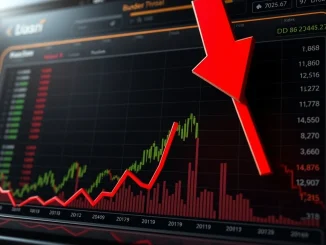
The decentralized finance (DeFi) landscape is constantly evolving, with innovation at its core. Today, the spotlight shines on a significant development that could reshape how we think about stablecoins: the launch of Resolv Protocol’s groundbreaking dynamic hedging mechanism. This strategic move has not only captured the attention of the crypto community but also fueled an impressive 7.21% surge in the RESOLV token price, signaling strong investor confidence in its vision for a truly capital-efficient stablecoin.
What is Resolv Protocol’s Dynamic Hedging Mechanism?
Resolv Protocol, a cutting-edge multi-chain stablecoin platform, has introduced a sophisticated fee-switch mechanism designed to enhance both flexibility and capital efficiency for its dollar-pegged stablecoin, USR. Unlike many traditional stablecoins, USR is uniquely collateralized by a blend of Ethereum (ETH) and Bitcoin (BTC). The protocol employs delta-neutral strategies to meticulously maintain its U.S. dollar peg, ensuring stability even amidst volatile market conditions.
The newly launched feature is a game-changer, allowing users to dynamically adjust collateral types and hedging parameters in real-time. This real-time adaptability is crucial for optimizing capital utilization and effectively mitigating risks associated with market volatility. Here’s how this innovative approach sets Resolv apart:
- Real-Time Adjustments: Users can modify delta-neutral hedging ratios on the fly, significantly reducing exposure to price swings in the underlying backing assets (ETH and BTC).
- Algorithmic Efficiency: It moves away from traditional over-collateralization models, leveraging algorithmic mechanisms and decentralized hedging strategies to minimize reliance on external liquidity providers.
- Enhanced Capital Utilization: By dynamically managing collateral, the protocol ensures that capital is used more efficiently, a key differentiator in the competitive stablecoin market.
Why the RESOLV Token Surge?
The announcement of this innovative mechanism coincided with a notable 7.21% surge in the RESOLV token price on July 1, 2025, reaching $0.1993. This price jump was driven by robust volume inflows, with Binance data highlighting RESOLV as one of the season’s top-performing altcoins. Analysts attribute this strong performance to several factors:
- Investor Confidence: The successful launch of a sophisticated risk management tool has clearly resonated with investors seeking more secure and adaptive stablecoin solutions.
- Focus on Capital Efficiency: The protocol’s emphasis on creating a truly capital-efficient stablecoin addresses a critical need in DeFi, attracting both institutional and retail participants.
- Technical Upgrades: The continuous technical advancements and commitment to innovation position Resolv Protocol as a leader in decentralized stablecoin development.
How Does USR Stablecoin Achieve Capital Efficiency?
The core of Resolv Protocol’s innovation lies in its approach to the USR stablecoin. By moving beyond simple over-collateralization, USR leverages a sophisticated combination of assets and strategies to maintain its peg while maximizing capital utility. This is achieved through:
- Delta-Neutral Strategies: These strategies aim to balance the exposure to price movements of the underlying collateral, ensuring that the net risk from price fluctuations is minimized.
- Dynamic Collateral Management: The fee-switch mechanism allows the protocol to adapt its collateral mix and hedging parameters based on real-time market conditions, preventing capital from being unnecessarily locked up.
- Algorithmic Backing: Instead of relying solely on centralized reserves, USR integrates algorithmic mechanisms that automate hedging and rebalancing, leading to more efficient use of capital.
This approach directly addresses the liquidity and risk management challenges prevalent in decentralized finance ecosystems, aligning perfectly with the growing demand for adaptive tools across fragmented blockchain networks.
Navigating the Competitive Stablecoin Landscape with Dynamic Hedging
The stablecoin market is fiercely competitive, especially with increasing regulatory scrutiny on centralized issuers. Resolv Protocol‘s multi-chain strategy further supports cross-platform liquidity, effectively bridging interoperability gaps that have historically hindered stablecoin adoption. Its open-source framework and community-driven governance model foster transparency and build trust in its robust risk management approach.
The protocol’s emphasis on decentralized collateral and dynamic fee adjustments positions it strategically to capture significant market share. The July 2025 price rally for the RESOLV token clearly underscores its potential to attract substantial capital amidst the evolving needs of the DeFi space. While critics rightly point to the need for robust on-chain infrastructure to ensure the mechanism functions effectively during extreme market conditions, Resolv’s proactive stance on adaptive risk management is a strong indicator of its long-term viability.
What’s Next for Resolv Protocol?
The success of the fee-switch mechanism will ultimately depend on its ability to balance groundbreaking innovation with operational resilience. While the protocol’s approach aligns with broader DeFi trends toward adaptive risk management, its sustained adoption will require demonstrating the mechanism’s effectiveness across diverse and challenging market conditions. The initial surge in the RESOLV token price indicates renewed investor confidence, but the true test lies in consistent performance and widespread utility.
In conclusion, Resolv Protocol’s launch of its dynamic hedging mechanism marks a significant step forward in the evolution of stablecoins. By prioritizing capital efficiency, real-time adaptability, and decentralized risk management, Resolv is poised to offer a compelling alternative in the DeFi ecosystem. As the market continues to mature, solutions like USR stablecoin, backed by innovative protocols, will be vital for fostering greater stability and broader adoption of decentralized finance.
Frequently Asked Questions (FAQs)
Q1: What is Resolv Protocol?
A1: Resolv Protocol is a multi-chain stablecoin platform that aims to provide a capital-efficient, dollar-pegged stablecoin called USR. It uses advanced delta-neutral strategies and dynamic hedging to maintain its peg and manage risk.
Q2: How does the dynamic hedging mechanism work?
A2: The dynamic hedging mechanism, or fee-switch, allows users to adjust collateral types and hedging parameters in real-time. It uses algorithmic processes to minimize exposure to price swings in its collateral assets (ETH and BTC), optimizing capital utilization and reducing reliance on traditional over-collateralization.
Q3: What is the USR stablecoin backed by?
A3: The USR stablecoin is collateralized by Ethereum (ETH) and Bitcoin (BTC), utilizing delta-neutral strategies to maintain its U.S. dollar peg.
Q4: Why did the RESOLV token price surge?
A4: The RESOLV token price surged by 7.21% following the announcement of the dynamic hedging mechanism. This surge was driven by strong volume inflows and investor confidence in the protocol’s focus on capital efficiency and technical upgrades, positioning it as a top-performing altcoin.
Q5: What challenges does Resolv Protocol face?
A5: While innovative, Resolv Protocol’s long-term viability depends on the robust functioning of its on-chain infrastructure, especially during extreme market conditions. Broader macroeconomic factors and regulatory developments also remain potential headwinds for adoption.
Q6: How does Resolv Protocol contribute to DeFi?
A6: Resolv Protocol addresses key DeFi challenges such as liquidity and risk management. Its multi-chain strategy improves interoperability, and its open-source, community-driven model fosters transparency, positioning it as a crucial player in the evolving decentralized finance landscape.



